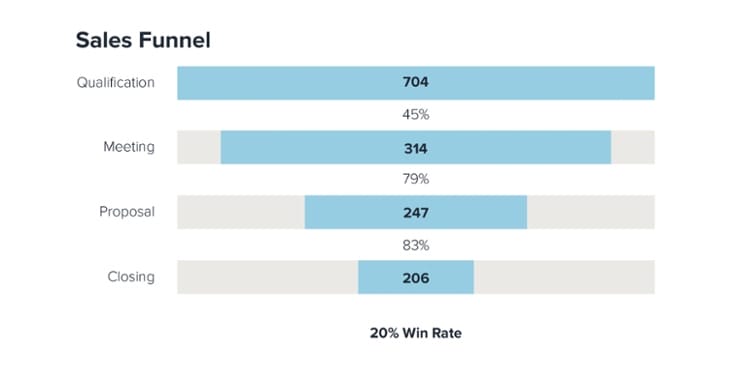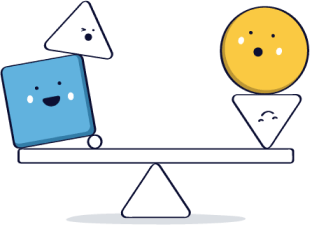Want to learn more about sales pipeline automation?
Learn how to set up your sales pipeline with custom automations to streamline your workflow and keep deals moving forward!

Om du har använt "pipeline" och "funnel" för att beteckna samma sak bör du kanske vara uppmärksam.
Försäljningspipeline och försäljningstratt beskriver båda flödet av prospekt genom en försäljning, men det finns en viktig skillnad mellan de två vanligt förvirrade termerna. Även om definitionen och innebörden av en försäljningspipeline jämfört med en försäljningstratt kan verka likartad, finns det några grundläggande skillnader.

Learn how to set up your sales pipeline with custom automations to streamline your workflow and keep deals moving forward!

A sales pipeline is a set of stages that a prospect moves through as they progress from a new lead to a customer. Once each pipeline stage is completed, the prospect is advanced to the next stage.
Även om strukturen kan skilja sig åt från företag till företag när man bygger upp en säljpipeline, följer här några av de vanligaste stegen:
Now, here’s where things start to get confusing.
1) A sales pipeline is similar—but not identical—to a sales process, which refers to the recurring actions that a team takes on every lead to move them across those stages (i.e., distributing leads to the proper team member, calling new leads to qualify them, or doing research in advance of a presentation). The actions in a sales process are divided into pipeline stages.
2) Many sales professionals use “pipeline” or “sales pipeline” to mean the quantity or dollar value of the deals currently in their pipeline, not the series of sales stages themselves. It’s very common to hear a sales rep lament that their “pipeline is looking rough” because they let their prospecting efforts fall by the wayside or to hear a manager call a “pipeline meeting” to discuss the specific deals that the team has in progress.
What they’re really talking about is deal pipeline value, which is measured by a pipeline report.
A pipeline report shows the value and quantity of all deals in each stage of the opportunity pipeline at the moment when the report is run.

Relaterat: Recept för säljpipeline: så botar du de 10 vanligaste sjukdomarna som plågar din pipeline
Pipeline reports are important for effective pipeline management, helping sellers keep track of the status of every deal and understand whether they have an appropriate distribution of deals in order to meet their sales targets.
While Nutshell uses the “series of stages” definition when referring to “sales pipelines” in our CRM, don’t be thrown off when you hear seasoned sales pros use it to mean “value of deals in progress.” As a wise band once sang, sometimes words have two meanings.

Perhaps you’re wondering what a sales pipeline looks like. A sales pipeline is typically depicted as a horizontal bar broken up into the different sales process stages. For example, the sales pipeline pictured above shows a horizontal series of pipeline stages from Qualify to Close.
Förändra din försäljningsprocess med vår omfattande utbildningsguide för försäljningspipelinen. Lär dig allt från att fylla din pipeline till pipelinehantering.

Till skillnad från en säljpipeline, som fokuserar på de åtgärder som säljarna vidtar, representerar en säljtratt antalet prospekt och konverteringsgraden för prospekt genom pipeline-stegen. Den kallas "tratt" på grund av sin form: bred längst upp när prospekten kommer in, sedan allt smalare när de diskvalificeras eller beslutar sig för att inte köpa.
Unlike a sales lead pipeline report, which shows the value and quantity of deals at the moment when the report is run, a funnel report is based on a cohort. This means that a funnel report can tell you, for example, of the 100 leads you received last quarter, what percentage of them advanced through each stage of your pipeline.

A sales cycle funnel report is important for sales leaders because it can help them forecast sales and identify where deals are getting stuck. A sales funnel forecast report is generated based on the current lead volume. And pinpointing bottlenecks in the funnel cycle helps them improve their process and better coach their team.

We know what a sales pipeline looks like—how does the look of a sales funnel differ? A sales funnel depicts the buyer journey in a vertical format, from when the lead enters the top of the funnel to the point at which the lead becomes a customer at the bottom.
Because the number of leads usually decreases from stage to stage, the sales funnel automatically takes on the shape of a funnel, as shown in the above picture of a sales funnel. For this reason, regardless of whether the funnel highlights the number of leads per stage or simply focuses on the types of stages in the sales process, the sales funnel is usually visualized in funnel form.
So, when you’re thinking about the difference between a pipeline and a funnel, remember this: A pipeline reflects what a seller does during the sales process and a funnel measures conversion rates through the sales process.
To sum up:
Få 70+ expertstrategier för framgångsrika säljchefer i vår överlevnadsguide för säljchefer.

As you’ve probably realized, the sales pipeline and sales funnel are moving in the same direction along the buyer’s journey from discovery to close. That’s why you can – and should – use both to determine your business’s sales strategy.
The conversion rates found in the sales funnel report are a response to things that your sales team can control – sales rep actions, how they communicate, and how often they’re reaching out and working to move leads through the sales deal pipeline.
When analyzing conversion rates in your sales funnel, keeping your sales pipeline on hand can help you map seller actions directly to buyer conversions and find opportunities to improve your process.
Building an effective sales opportunity pipeline may seem complicated at first—there are several factors to consider to ensure you get it right. With a straightforward process in hand, building a sales lead pipeline geared toward moving prospects through the stages and encouraging more deals is simplified.
Let’s take a look at the core steps to create the best sales pipeline for your team and business success:
You’ve followed the steps outlined above and built a great sales pipeline to empower your sales team. What next? The next step is to implement a solid pipeline management process so you, your team, and your company get the most from your sales efforts.
We’ve already touched on continuous pipeline evaluation and optimization, but there’s more to pipeline management than just that. Here are some of the top tips for successfully managing a sales pipeline:
Want to turn your sales pipeline into a conversion machine? Take a tour of Nutshell and learn how our CRM’s sales process tools and insights help sales reps add more qualified leads to their pipeline and win more deals.
And with our Multiple Pipelines feature, Nutshell Pro users can even configure multiple sets of stages for distinctly different sales efforts.
After exploring our robust suite of CRM features, why not try it out for yourself? Explore any Nutshell plan free for 14 days – no credit card required. Contact our team to learn more about how Nutshell can help your business create the ideal sales pipeline, whatever your sales model.
Have a question? Need to see more? Register for a free 30-minute Nutshell demo and product tour with one of our team members to determine if Nutshell is a match for your business.


Gå med i 30 000+ andra proffs inom försäljning och marknadsföring. Prenumerera på vårt nyhetsbrev Sell to Win!
 Synkronisering av e-post och kalender
Synkronisering av e-post och kalender
Use our calculator to add up your total investment of CRM and Add-ons
VIEW ALL PRICING
 Produktinformation
Produktinformation Utbildning & guider
Utbildning & guider Företag
Företag